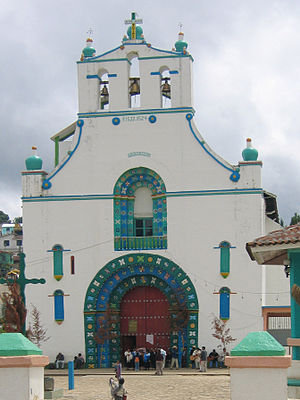Chamula
| Chamula | |
|---|---|
| Municipality | |
 |
|
| Location in Mexico | |
| Coordinates: 16°47′N 92°41′W / 16.783°N 92.683°W | |
| Country |
|
| State | Chiapas |
| Population (2010) | |
| • Total | 76,941 |
San Juan Chamula is a municipio (municipality) and township in the Mexican state of Chiapas. It is situated some 10 km (6.2 mi) from San Cristóbal de las Casas. As of 2010, the municipality had a total population of 76,941. Virtually the entire population of the municipality is indigenous and speaks an indigenous language. In 2010, the census reported that 99.5% of the population age 3 years or older speaks an indigenous language. The Tzotzil ethnic group and language dominate the municipality.
Chamula is located in the Chiapas highlands, at an altitude of 2,200 meters (7,200 feet); it is inhabited by the indigenous Tzotzil Maya people, whose Tzotzil language is one of the Mayan languages.
The town enjoys unique autonomous status within Mexico. No outside police or military are allowed in the village. Chamulas have their own police force. One of the best ethnographic descriptions of Chamula in English is Chamulas in the World of the Sun by Gary H. Gossen.
As of 2010, the town of Chamula had a population of 3,329. Other than the town of Chamula, the municipality had 149 localities, the largest of which (with 2010 populations in parentheses) were: Cruztón (1,756), Yaltem (1,664), Chicumtantic (1,599), Nichnamtic (1,496), Muquén (1,480), Majomut (1,450), Saclamantón (1,348), Catishtic (1,319), Romerillo (1,310), Cuchulumtic (1,275), Narváez (1,207), Bautista Chico (1,173), Las Ollas (1,165), Macvilho (1,142), Tentic (1,121), Arvenza Uno (1,107), Pugchén Mumuntic (1,046), and Tzontehuitz (1,004), classified as rural.
The church of San Juan, in the municipal cabecera (headtown), is filled with colorful candles, and smoke from burning copal resin incense, commonly used throughout southern Mexico. Along the walls of the church, as in many Catholic churches, are dressed-up wooden statues of saints in large wooden cases, many wearing mirrors to deflect evil. The local form of Catholicism is a blend of pre-conquest Maya customs, Spanish Catholic traditions, and subsequent innovations.
...
Wikipedia

